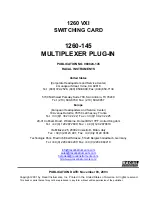
Chapter II
5000-count portable digital multimeter, with current input
19
3. GETTING
STARTED
3.1.
Connecting the test leads
Connect the black lead to the COM socket (for all measurements). Depending on the
position of the selector switch, connect the red lead as follows:
Rotary selector switch position
Input terminal
V
LOW Z
, V
AC+DC
, V
DC
,
ADP
DC
(ADP
AC+DC
), FREQ,
,
Ω
,
,
V
Ω
50 mA
DC
(50 mA
AC+DC
)
50 mA
10 A
DC
(10 A
AC+DC
)
10 A
3.2.
Switching on the instrument
The selector switch is on the OFF position.
Turn the selector switch to the required function.
All segments of the display come on for a few seconds. The instrument is then ready for
measurements.
3.3.
Switching off the instrument
The instrument can be switched off manually by returning the selector switch to the OFF
position, or automatically after approximately half an hour if no key is pressed or the
switch is not operated.
"
Note
For user safety, automatic shutdown is also disabled when a measured
magnitude (voltage/current) present at the input exceeds dangerous level
(
indicator displayed).
3.4. Special
configuration
To adapt the configuration of the instrument to the measurement environment, the user
can choose 50 Hz or 60 Hz rejection :
Switch on with the rotary switch while holding down the MEM key. The selection is
reversed from the last configuration, is displayed for two seconds and remains backed
up in non-volatile memory.
3.5. Multimeter
maintenance
3.5.1. Fuse self-test
This check can be carried out with the multimeter in use without opening up the casing.
- 0.63 A fuse (F1) : set the rotary switch to the
position and short-circuit the 50 mA and
V
Ω
sockets. The display should read approx. 0.001 V. If the digital display indicates an
overflow « .OL ». The fuse is blown.
- 10 A fuse (F2) : set the rotary switch to the
position and short-circuit the COM and V
Ω
sockets. The display should read approx. 0.001 V. If the digital display indicates an
overflow « .OL ». The fuse is blown.
















































